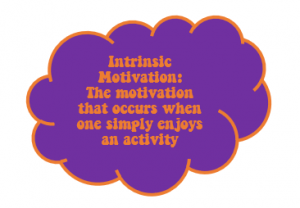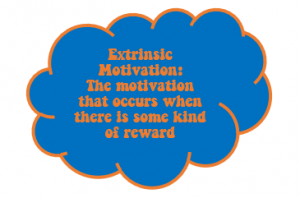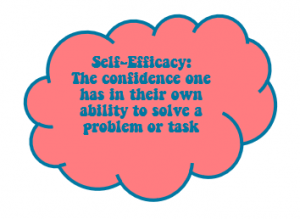11
Whitney Groeger
Assuming that you have read the first chapter of this book let’s expand on the importance of using psychological research in your coaching styles! Before we get onto the application lets discuss the background knowledge.
 One important thing to understand is the varying degrees of motivation within your athletes. Though I’m sure that most everyone is familiar with the terms intrinsic and extrinsic motivation, I’m sure very few actually know what they mean. Intrinsic motivation is the action in which people do something for the sheer pleasure or fun of doing something while extrinsic motivation is the action in which someone does something for some kind of prize or reward (social or physical). This is important to note in context to your athletes. While some of your athletes (like myself) may be choosing to cheer because they genuinely enjoy the sport, others may have joined to please a parent or because of social motivations. Understanding these motivations can determine what kind of athlete you are dealing with. Intrinsic motivation stems from the feeling of competence in any given area and is also self-determined to produce a positive result. For me, I have always felt that I am very capable of becoming a wonderful athlete within the world of cheerleading and I have an internal motivation to do well because I genuinely enjoy it. For others, the title of “cheerleader” and the perceived popularity of it is the main motivating factor in joining the squad, and thus the internal motivation to do well may be low once they have the title. Having now been a cheerleader for many years I have seen this type of athlete time and time again. You
One important thing to understand is the varying degrees of motivation within your athletes. Though I’m sure that most everyone is familiar with the terms intrinsic and extrinsic motivation, I’m sure very few actually know what they mean. Intrinsic motivation is the action in which people do something for the sheer pleasure or fun of doing something while extrinsic motivation is the action in which someone does something for some kind of prize or reward (social or physical). This is important to note in context to your athletes. While some of your athletes (like myself) may be choosing to cheer because they genuinely enjoy the sport, others may have joined to please a parent or because of social motivations. Understanding these motivations can determine what kind of athlete you are dealing with. Intrinsic motivation stems from the feeling of competence in any given area and is also self-determined to produce a positive result. For me, I have always felt that I am very capable of becoming a wonderful athlete within the world of cheerleading and I have an internal motivation to do well because I genuinely enjoy it. For others, the title of “cheerleader” and the perceived popularity of it is the main motivating factor in joining the squad, and thus the internal motivation to do well may be low once they have the title. Having now been a cheerleader for many years I have seen this type of athlete time and time again. You  know the one who is goofing off in the back or seemingly appears to not care when it comes to learning material and yet her excitement to be a part of the team was palpable during tryouts? This kind of athlete will have to be motivated in different ways than the intrinsically motivated one and thus you will have to adapt how you motivate your team to fit these styles. Although that’s not to say that every athlete will perfectly fit within each motivation style some may have a bit of each motivation or change their motivation depending on the day. Motivation is fueled by many different factors and can be very fluid depending on varying experiences. (Eccles & Wigfield, 2002)
know the one who is goofing off in the back or seemingly appears to not care when it comes to learning material and yet her excitement to be a part of the team was palpable during tryouts? This kind of athlete will have to be motivated in different ways than the intrinsically motivated one and thus you will have to adapt how you motivate your team to fit these styles. Although that’s not to say that every athlete will perfectly fit within each motivation style some may have a bit of each motivation or change their motivation depending on the day. Motivation is fueled by many different factors and can be very fluid depending on varying experiences. (Eccles & Wigfield, 2002)
 Another important term to learn is self-efficacy. Self-efficacy is the individual’s confidence in their ability to organize and execute a given course of action to solve a problem or accomplish a task. Building self-efficacy within your athletes is so important particularly within cheerleading. Self-efficacy is something that can’t be given directly to your athletes. It is a process gained through repeated positive reinforcement. For example if your athletes regularly fail at a skill they will lose the confidence in their ability to execute that skill. In many instances in life this can translate into simply having or not having a certain skill but cheerleading is another breed in itself. In our sport, if your athletes do not believe in their abilities they may pose a danger to themselves or others. I know from personal experience that there were many pyramids that I was a part of that would not have hit unless every person believed that they could execute their given part; it only took one unconfident ‘cog’ in the machine to create a domino effect. As a coach, you can encourage this self-confidence with a healthy dose of encouragement with every critique you give. (Eccles & Wigfield, 2002)
Another important term to learn is self-efficacy. Self-efficacy is the individual’s confidence in their ability to organize and execute a given course of action to solve a problem or accomplish a task. Building self-efficacy within your athletes is so important particularly within cheerleading. Self-efficacy is something that can’t be given directly to your athletes. It is a process gained through repeated positive reinforcement. For example if your athletes regularly fail at a skill they will lose the confidence in their ability to execute that skill. In many instances in life this can translate into simply having or not having a certain skill but cheerleading is another breed in itself. In our sport, if your athletes do not believe in their abilities they may pose a danger to themselves or others. I know from personal experience that there were many pyramids that I was a part of that would not have hit unless every person believed that they could execute their given part; it only took one unconfident ‘cog’ in the machine to create a domino effect. As a coach, you can encourage this self-confidence with a healthy dose of encouragement with every critique you give. (Eccles & Wigfield, 2002)
The third piece of information that may be helpful in understanding your athletes is the idea of an identity crisis. Although we may associate that “mid-life crisis” to adults it’s actually very common for adolescents between the ages 15-17 to go through their own identity crisis, so common in fact that about 50% of teens go through this stage. This is due to societal pressures, as well as physical growth, sexual maturity, and the growth of brain matter to understand how they are perceived by others. When we as humans are faced with stressful situations (school and just growing up in the case of adolescents) this can cause us to question who we are as a person and where we belong in society, thus the parts of us that make up our sense of self. This can be extremely hard to manage as an adult let alone as a child. Although there is no way to prevent this stage, and not every adolescent goes through it, the best thing we can do as adults is to be a listening ear. As a coach, you have the unique opportunity to create a relationship with your athletes that is completely different from the one that they have with their parents. As a coach you have a chance to be their mentor in a place that (most of the time) they chose for themselves! This is huge! Much of our kids’ lives are chosen for them, what they eat for dinner, what school they go to etc. Motivations change when we feel in control. They chose this sport and in a way they chose you, don’t let them down! Teach them and mentor them in ways that empower them to take pride and ownership in their team; when they feel a sense of ownership in the team they will be more motivated to excel. This sense of ownership will help them to take control of their identity in the future. You can do this by encouraging good intergroup relations and not only talking about good leadership but by showing it. The foundations that my coaches taught me about working with others and the lessons they taught me by modeling good leadership are some lessons that I know I will always remember. After all working as a team is something that we all have to do either as a family or within the workplace and these are powerful skills to learn at a young age. (Crone & Fuligni, 2019).
RECAP & EXPANSION
Intrinsic vs Extrinsic Motivations
So now that you know a little bit more about intrinsic vs extrinsic motivation let’s talk about how this can be applicable to your team. Once you can identify what motivates your team you can better encourage your athletes to succeed. To do this, pay close attention to each of your athletes during the tryout process and directly after. Do they generally get excited to learn routines or are the uniforms the most exciting part? If they tend to get excited to learn routines then that makes your job as a coach so much easier, if not this will be something for you to consider within your coaching style. If they are motivated by the social aspects that come with the cheerleading or the pom poms use those things as a reward. For example, my coaches in high school had this thing called “Cheerleader of the Week ” this title was bestowed upon one cheerleader for each game. This was an honor for those who got it to receive as there were more girls than there were games! This cheerleader got to wear the special bow for that game and got to use the special pair of poms as well as get a personal feature on our social media. This honor was given to the cheerleader who put in the most effort that week, whether that was a good attitude at practice or simply taking the time to really master a skill. This cheerleader was given both the social recognition by their peers and the fun of getting to use the extra sparkly poms! This kept the cheerleaders who weren’t as intrinsically motivated working hard to try and receive this ‘prize’. Even though extrinsic motivations are psychologically less powerful, they can be used as a means-end to help jump-start a cheerleader whose motivation is holding them back. Ultimately a coach will want to help their cheerleaders internalize their motivations, but you have to start somewhere, and sparkly pom-poms are great for that!
Self-Efficacy
If self-efficacy is the act of one’s confidence to produce a given result, what can we as coaches do to help encourage this confidence, you may be asking? We can demonstrate good technique from many different angles. One major way that I have learned to stunt, in particular, is by watching demonstrations by others who are proficient and clean in the stunt we are attempting to do. This is why it is so important to get your athletes involved with things like summer camps. At cheer summer camps your team will be exposed to paid experienced athletes to show your team the ropes. As your athletes get more experienced this may not be quite as crucial but all ages really can benefit from direct instruction paired with demonstrations. The instruction gives the athletes a baseline understanding of the skill and the demonstrations allow the athletes to visualize a final product. With the added trial and error of practice that leads to success, efficacy is built. Once they have the technique down and see that it’s possible, your athletes will gain a level of confidence that they know the technique and the only thing left to focus on is hitting it. That’s where a healthy level of encouragement to your athletes comes in! This is essential in boosting self-worth which is another key component in your athletes confidence. I know my confidence in hitting stunts as a longtime cheerleader stems from the repetition of both the motion of the stunt and my coaches’ encouragement. Overtime, this has built up the emotional strength in me to be able to hit just about anything!
Identity Crisis
The final piece of this chapter is about the identity crisis that many teens face. Although this detail may seem to be a bit irrelevant to helping you become a better coach, it really isn’t. Part of being a good coach is being sensitive to the adolescent experience. Within adolescence kids are at the beginning of learning how to deal with difficult situations. It’s important that we as coaches guide them through these moments smoothly as this will eventually reflect how our athletes will face similar difficulties later in life. In guiding them, this translates into how we give constructive criticism as well as how we react to a child’s mistakes. When we react in a good manner we promote a healthy level of self-reflection and a motivation to do better, but when we don’t, we kill the motivation needed to grow thus receiving feedback becomes null and void. Not only does it affect you in the moment (ie: you won’t see the needed corrections fulfilled by said cheerleader) but you also risk hurting your athletes feelings which could ultimately hurt their identity development. Writing this I can’t help but think back to one of my coaches in high school who gave me the once over and told me straight up that I wasn’t a good dancer. Although I am a strong personality and used that to fuel myself to get better, for many the implication that was made both verbally and non-verbally (the look) would have been enough to shatter their self-worth. This is a crucial time in development for teens to build their identity and it’s up to strong coaches and mentors to help in making this transition as smooth as possible while these adolescents transition into adulthood. Part of how you build a strong lasting character in your athletes is to model what it means to be a good leader. Take the time to hear their thoughts, if you can do the conditioning with your athletes, if you want your athletes to eat healthier eat the carrots too! Model the kind of behavior/character that you want to see within your athletes and I can almost guarantee that it will make all the difference in your team dynamic.
In summary, motivation and confidence are critical points in adolescence development which are shaped by lived experiences and can be fostered by coaching. As a coach you have the power to influence self-worth and confidence within your athletes through your words and actions. Set the stage for your athletes to be successful by teaching to their motivation levels and challenging them to achieve skills, but be mindful in how you do this as kids are in the process of figuring out their identity. The way in which you support your athletes in becoming more autonomous (independent and self-achieving) will ultimately have a powerful impact on them going forward. Educating yourself and recognizing this, is the first step in being the best coach you can be for your athletes.
References
Crone, E. A. & Fuligni, A. J. (2019). Self and others in adolescence. Annual Review of Psychology, 71, 447 – 469. https://doi.org/10.1146/annurev-psych-010419-050937
Eccles, J. S. & Wigfield, A. (2002). Motivational beliefs, values, and goals. Annual Review of Psychology, 53, 109 – 132.
